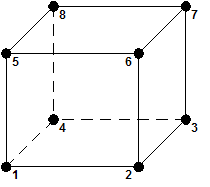Brick u-p Element
- Command_Manual
- Tcl Commands
- Modeling_Commands
- model
- uniaxialMaterial
- ndMaterial
- frictionModel
- section
- geometricTransf
- element
- node
- sp commands
- mp commands
- timeSeries
- pattern
- mass
- block commands
- region
- rayleigh
- Analysis Commands
- Output Commands
- Misc Commands
- DataBase Commands
BrickUP is an 8-node hexahedral linear isoparametric element. Each node has 4 degrees-of-freedom (DOF): DOFs 1 to 3 for solid displacement (u) and DOF 4 for fluid pressure (p). This element is implemented for simulating dynamic response of solid-fluid fully coupled material, based on Biot's theory of porous medium.
Please click here for examples.
OUTPUT INTERFACE:
Pore pressure can be recorded at an element node using OpenSees Node Recorder:
recorder Node <-file $fileName> <-time> <-node ($nod1 $nod2 …)> -dof 3 vel
See OpenSees command manual (McKenna and Fenves 2001) for nodal displacement, velocity, or acceleration recorders.
The valid queries to a BrickUP element when creating an ElementRecorder are 'force', 'stiffness', or 'material matNum matArg1 matArg2 ...', where matNum represents the material object at the corresponding integration point.
| element brickUP $eleTag $Node1 $Node2 $Node3 $Node4 $Node5 $Node6 $Node7 $Node8 $matTag $bulk $fmass $PermX $PermY $PermZ <$bX=0 $bY=0 $bZ=0> |
| $eleTag | A positive integer uniquely identifying the element among all elements |
| $Node1,… $Node8 | Eight element node (previously defined) numbers (see figure above for order of numbering). |
| $matTag | Tag of an NDMaterial object (previously defined) of which the element is composed |
| $bulk | Combined undrained bulk modulus Bc relating changes in pore pressure and volumetric strain, may be approximated by:
Bc ≈ Bf/n where Bf is the bulk modulus of fluid phase (2.2x106 kPa (or 3.191x105 psi) for water), and n the initial porosity. |
| $fmass | Fluid mass density |
| $permX, $permY, $permZ | Permeability coefficients in x, y, and z directions respectively. |
| $bX, $bY, $bZ | Optional gravity acceleration components in x, y, and z directions directions respectively (defaults are 0.0) |
NOTE:
This element requires 4 degrees-of-freedom (ndf=4), the 4th degree-of-freedom being pore pressure. The Pore pressure can be recorded at an element node using OpenSees Node Recorder:
recorder Node <-file $fileName> <-time> <-node ($nod1 $nod2 …)> -dof 4 vel
The valid queries to a BrickUP element when creating an ElementRecorder are 'force', and 'material matNum matArg1 matArg2 ...', where matNum represents the material object at the corresponding integration point.
TYPICAL RANGE OF PERMEABILITY COEFFICIENT (cm/s)
| Gravel | Sand | Silty Sand | Silt | Clay |
| >1.0x10-1 | 1.0x10-3 ~ 1.0x10-1 | 1.0x10-5 ~ 1.0x10-3 | 1.0x10-7 ~ 1.0x10-5 | <1.0x10-7 |
Code Developed by: UC San Diego (Dr. Zhaohui Yang):
UC San Diego Soil Model:
- Element Command
- UC San Diego u-p element (saturated soil)
- NDMaterial Command
- UC San Diego soil models (Linear/Nonlinear, dry/drained/undrained soil response under general 2D/3D static/cyclic loading conditions (please visit UCSD for examples)
- UC San Diego Saturated Undrained soil
- Related References
